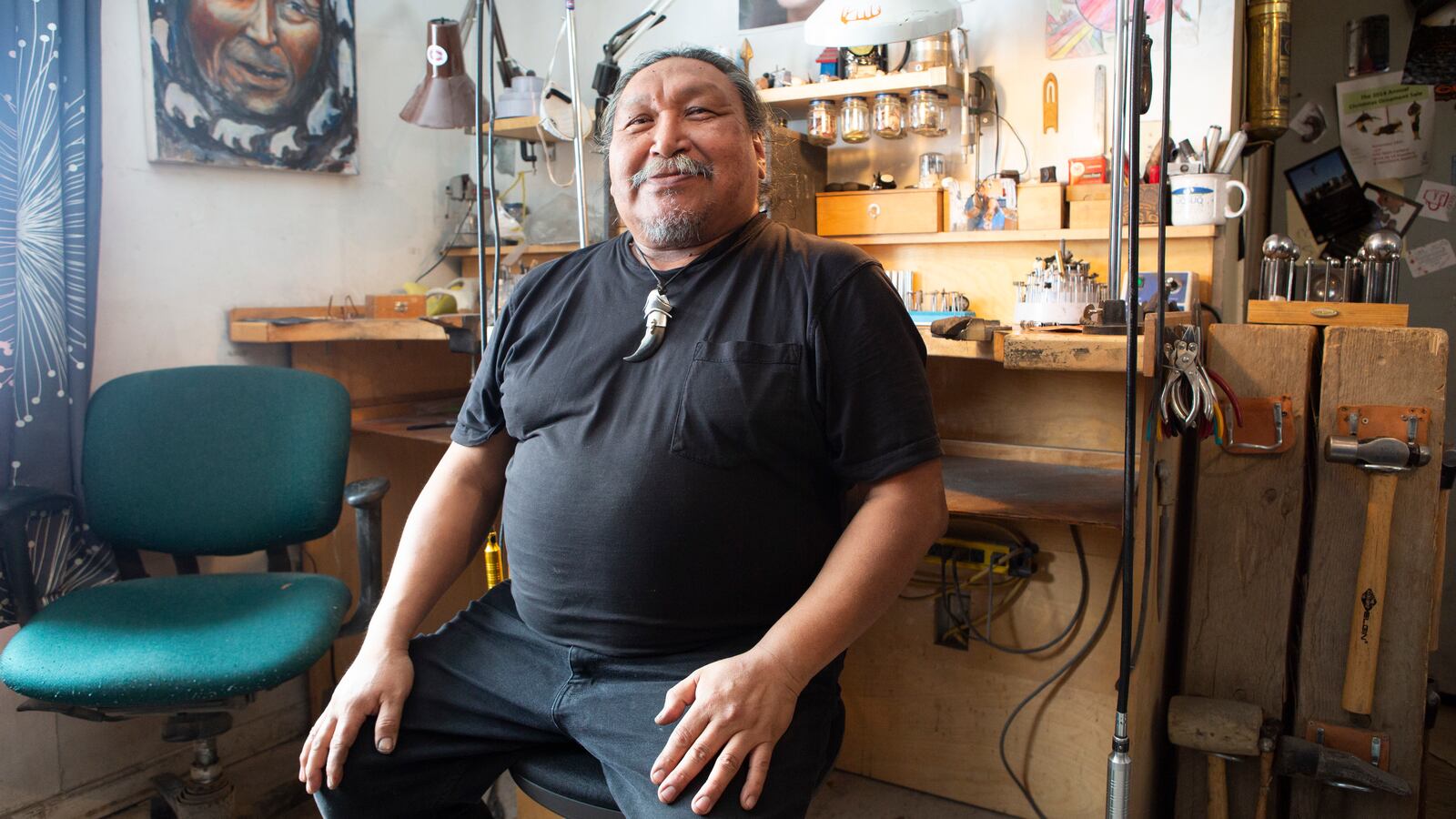Prince Charles, rock guitarist Joe Satriani and models of Paris Fashion Week don’t have much in common, but they have all worn accessories crafted by Mathew Nuqingaq.
From the street, Nuquingaq’s workshop looks like most homes in Iqaluit, the capital of Nunavut, the most northerly territory of Canada. It is squat with brown aluminum siding, and surrounded by snow.
But inside is a warm, well-organized jewelry workshop filled with tools, found objects, and glistening finished pieces of jewelry displayed in a glass case. There’s an acoustic guitar and local art covering the walls and soft music filling the room.

Mathew Nuqingaq in his Iqualuit Studio.
Sarah Rogers/The Daily BeastNuqingaq is well-known in his community: he’s the president of the Inuit Art Foundation, he was named to Order of Canada in 2016, and his jewelry and sculptures are displayed in several gift shops and museums within town. But outside of the Iqaluit’s population of 8000, his work has also caught the attention of royals, rock stars and the fashion world.
In a June 2017 visit to Iqaluit, Prince Charles was gifted a pair of Nuqingaq’s snow goggles, which he and wife Camilla both sported with a smile.

Prince Charles, Prince of Wales and Camilla, Duchess of Cornwall wear Mathew Nuquingaq’s snow goggles at a community feast event at Sylvia Grinnel Territorial Park, June 29, 2017 in Iqaluit, Canada.
Chris Jackson/Getty / ShutterstockEarlier this month, Joe Satriani posted an Instagram video wearing a custom pair of Nuquingaq’s snow shades.
In March, Victoria Arctic Fashion collaborated with Nuqingaq for a Flying Solo Paris Fashion Week presentation.

Mathew Nuqingaq’s silver earrings seen during Flying Solo’s 2019 Paris Fashion Week show.
Courtesy Flying SoloBorn off the east coast of Baffin Island, Nuqingaq has lived in Iqaluit about 30 years. After teaching kindergarten and taking night classes learning the art of jewelry making, he found himself falling in love with the practice. He quit his teaching job to pursue making jewelry full-time, and—twenty years on—he has crafted endless modern takes on traditional Inuit culture and animals from the region.
Arctic animals, whale tales, bird silhouettes, and caribou antlers are all recurring themes in Nuqingaq’s jewelry. Silver earrings representing Quilliuqs, the traditional oil lamp used by indigenous peoples in the arctic to warm their homes, are also popular designs from his shop.

A silver whale tale in progress.
Sarah Rogers/The Daily Beast“I’ve been trying to simplify my work for most of my life,” Nuqingaq explained. “You can say so much with very little.”
Perhaps what Nuqingaq’s Aayuraa Studio is most known for, and named after, is his snow goggles.
Nuqingaq’s goggle design is not only sleek but functional—the small slit shows just enough space for the wearer to see the horizon, and blocks the wearer's eyes from the harsh bright reflection of arctic snow. Living just shy of the arctic circle, eye protection when spending the day outside is an essential.
Matthew’s jewelry is primarily silver and copper, but he’s also used bone, wood and other found materials. “Materials are everywhere,” Nuqingaq said. “Lately I’ve been recycling copper. The [silver] material I get from Toronto. Lots of the materials are from the stuff that we eat … the bone, the tusks. We use every bit of the animal.”
The process for his silver and copper pieces is complicated and skillful: First he flattens sheets of copper and silver with a rolling device until nearly paper-thin, readying them to shape.
After flattening the metal, Nuqingaq heats the metal, hammers it, and reheats it to bend again. “When you hammer it, it curves [the metal], and also gives it strength. Kind of like a backbone.”

Nuqingaq hammers a piece of copper, left, creating his signature seam. He then heats up the copper, right, to unfold the piece.
Sarah Rogers/The Daily Beast“You heat it up, and the molecules become relaxed. Then you dip it in water when its almost red-hot,” he explained.
The piece is polished and, after the desired shape is achieved, the metal is so thin it can be meticulously cut with scissors. The final result can be achieved quickly, or take years, Nuqingaq said.
Between his celebrity clients and art shows (he’s currently exhibiting in Toronto's Feheley Fine Arts), Nuquingaq is constantly creating but never runs out of inspiration.
“There are so many ideas,” Nuqingaq said of his work. “There’s not enough time in the day.”

